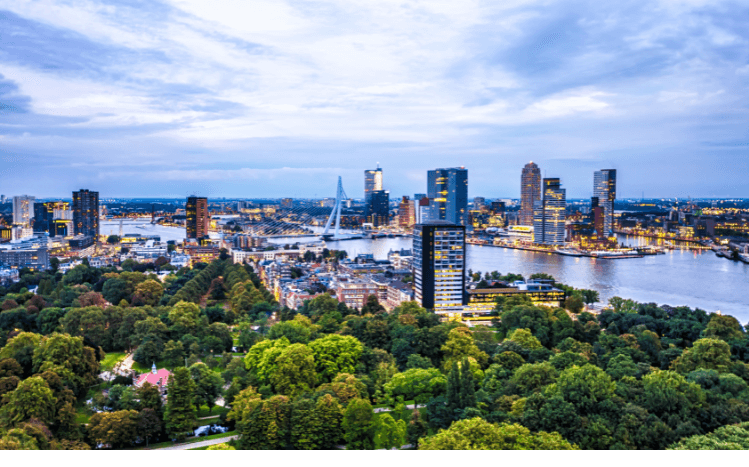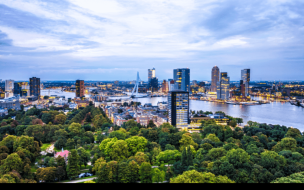The impact of circular economy model for the planet could be transformative. The system could help to reduce pollution, regenerate nature, and prevent the rapid decline of our planet’s future.
Out of the 100 billion tons of raw materials that are taken from the Earth each year, only 8.6% of these materials are cycled back into the economy, according to the Circularity Gap Report 2022.
If society continues this path, the same study reports that material use is predicted to increase to 184 billion tons per year by 2050. It’s imperative that a framework is put in place to curb the amount of waste that is created.
What is the circular economy in a business context?
In a nutshell, the basis of the circular economy is a straightforward concept to understand. Everything that comes from the Earth should always be part of a circular value chain, rather than being discarded as waste.
However, combining this model with business strategy can be more difficult.
Lawrence Pratt is a professor of sustainable business at Rotterdam School of Management (RSM) in the Netherlands and researches circular economy business models. He also teaches entrepreneurship at INCAE Business School.
“Every company has to look at the principles of a circular economy and figure out which elements their company can take advantage of,” he says.
Lawrence teaches sustainable business to MBA Rotterdam students. Core courses on the RSM MBA program include Innovation Management, Sustainability, and Advanced Sustainability.
“When I teach MBAs the circular economy, we do a philosophical introduction but then take it apart as we look at different pieces within the operations of a company,” he says.
To apply the circular economy to a business context, RSM MBA students explore various case studies that look at product design, waste management, and issues of stakeholder management.
Businesses must consider each section of the supply chain to become circular, rather than just what happens to the product at the end of its life.
“MBAs aren’t there to decide what raw materials to use, but to give an understanding of what circular means and how to connect that to business strategy. They’ll look at supply chain issues, climate footprint, environmental factors, and work out how to manage KPIs alongside climate change,” Lawrence says.
The need for those who can bridge the gap between business and environmental challenges is greatly increasing in companies, he adds, so there are career benefits to learning about circular economy business models.
How can companies employ circular economy business models?
Adopting a circular economy business model is not a quick process.
“It takes an entire rethink of raw materials, of processes, and particularly how waste gets reincorporated as an input into other things,” says Lawrence.
He explains that for businesses who work on a global scale—sourcing raw materials, manufacturing, and distributing products in different locations across the world—products cannot be pulled back into the original supply chain so should be designed to go into another value chain.
By designing a product with reusability or recyclability at the forefront, companies will create a circular lifespan as well as build customer appreciation for sustainability and brand transparency.
Sustainability is becoming a top priority for younger consumers with 40% of Generation Z (Gen Z) respondents stating they would boycott an unsustainable brand, according to Ogilvy.
The circular economy is a business model supported by governance, particularly in Europe. In 2020, the European Union adopted a new Circular Economy Action Plan—a course of action designed to benefit both businesses and the planet.
The Netherlands is leading Europe’s transition towards a circular economy with a goal to operate a circular economy by 2050.
The country’s booming startup scene is home to circular businesses such as Donorstaal, a company that reuses steel, and Saltrex, an auction platform that rescues goods worldwide from incineration.
These startups are supported by Dutch bank ABN AMRO—a hirer of Rotterdam MBA grads.
Cross-industry collaboration will be needed to create a truly circular economy that has a real impact on the planet.
What could be the impact of a circular economy?
The potential positive impact of the circular economy is not solely environmental, but comes with strong financial benefits too—both for individual businesses and the wider economy.
Creating a widespread circular economy has the potential to offer $4.5 trillion to the global economy by 2030, according to the World Economic Forum. This is by reducing waste, creating jobs, and stimulating innovation.
It is estimated that six million jobs worldwide could be created.
Individual businesses will also benefit from becoming circular.
“You can bring consumers a better product, a better price with good profit margins that doesn’t impose a cost on the rest of society,” says Lawrence.
The vast number of raw materials that are currently being extracted and turned to waste is having a catastrophic impact on the planet.
Circular practices could reduce global material use and extraction by 28% and cut greenhouse gas emissions by 39%, according to the Circularity Gap Report 2022.
“We have a planetary need to manage raw materials better. By looking at more efficient use of raw materials at a global scale, we lengthen our access to valuable raw materials,” says Lawrence.
“The implications of doing this at a global scale potentially help buy us another 200 years of human habitation on Earth. If we figure out how to do it,” he says.
With the current state of climate change, sustainability in business is non-negotiable. This means that across industries there is an increasing demand for MBA grads who understand how to implement the right strategies for business performance and social impact.
“The circular economy is one of the big issues that MBAs have to understand because it is becoming increasingly business critical,” says Lawrence.








